Troyes
Troyes (French pronunciation: [tʁwa] (![]()
Troyes | |
|---|---|
Prefecture and commune | |
Buildings in the historic quarter of Troyes | |
Flag  Coat of arms | |
Location of Troyes 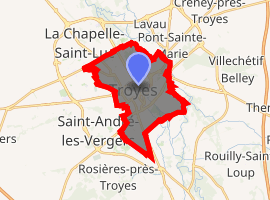
| |
 Troyes 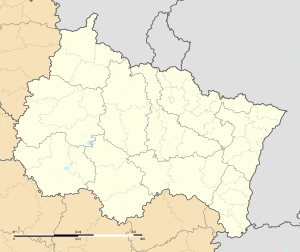 Troyes | |
| Coordinates: 48°17′59″N 4°04′45″E | |
| Country | France |
| Region | Grand Est |
| Department | Aube |
| Arrondissement | Troyes |
| Canton | Troyes-1 Troyes-2 Troyes-3 Troyes-4 Troyes-5 |
| Intercommunality | CA Troyes Champagne Métropole |
| Government | |
| • Mayor (2014-2020) | François Baroin (LR) |
| Area 1 | 13.2 km2 (5.1 sq mi) |
| Population (2017-01-01)[1] | 61,652 |
| • Density | 4,700/km2 (12,000/sq mi) |
| Time zone | UTC+01:00 (CET) |
| • Summer (DST) | UTC+02:00 (CEST) |
| INSEE/Postal code | 10387 /10000 |
| Elevation | 100–126 m (328–413 ft) (avg. 118 m or 387 ft) |
| 1 French Land Register data, which excludes lakes, ponds, glaciers > 1 km2 (0.386 sq mi or 247 acres) and river estuaries. | |
Troyes is situated within the Champagne wine region and is near to the Orient Forest Regional Natural Park. Many half-timbered houses (mainly of the 16th century) survive in the old town. Troyes has been in existence since the Roman era, then known as Augustobona Tricassium, which stood at the hub of numerous highways, primarily the Via Agrippa.
History
- For the ecclesiastical history, see bishopric of Troyes
The geographical location of Celtic grave-mounds around Troyes and the discovery of Celtic artifacts in the City grounds suggest that Troyes as a settlement may have originated with the Celts as early as 600 BC.[2]
In the Roman era, it was known as Augustobona Tricassium. Numerous highways intersected here, primarily the Via Agrippa, which led north to Reims and south to Langres, and eventually to Milan.[3] Other Roman routes from Troyes led to Poitiers, Autun and Orléans.[4] It was the civitas of the Tricasses,[5] who had been separated by Augustus from the Senones. Of the Gallo-Roman city of the early Empire, some scattered remains have been found, but no public monuments, other than traces of an aqueduct. By the Late Empire the settlement was reduced in extent, and referred to as Tricassium or Tricassae, the origin of French Troyes.
From the fourth century AD, the city was the seat of a bishop. The legend of its bishop Lupus (Loup), who saved the city from Attila by offering himself as hostage, is hagiographic rather than historical.[6] It was several centuries before Troyes gained importance as a medieval centre of commerce.
The Battle of the Catalaunian Plains, also called The Battle of Troyes, was fought nearby in 451 AD, between the Roman general Flavius Aetius and the Visigothic king Theodoric I against Attila.
In the early cathedral on the present site, Louis the Stammerer in 878 received at Troyes the imperial crown from the hands of Pope John VIII. At the end of the ninth century, following depredations to the city by Normans, the counts of Champagne chose Troyes as their capital. It remained the capital of the Province of Champagne until the Revolution of the late eighteenth century. The Abbey of Saint-Loup developed a renowned library and scriptorium.
During the Middle Ages, Troyes was an important trading town, and gave its name to troy weight. The Champagne cloth fairs and the revival of long-distance trade, together with new extension of coinage and credit, were the drivers of the medieval economy of Troyes.
In 1285, when Philip the Fair united Champagne to the royal domain, the town kept a number of its traditional privileges. John the Fearless, Duke of Burgundy and ally of the English, in 1417 worked to have Troyes designated as the capital of France. He came to an understanding with Isabeau of Bavaria, wife of Charles VI of France, that a court, council, and parlement with comptroller's offices should be established at Troyes. On 21 May 1420, the Treaty of Troyes was signed in this city, still under control of the Burgundians, by which Henry V of England was betrothed to Catherine, daughter of Charles VI. Under the terms of the treaty, Henry V was to succeed Charles, to the detriment of the Dauphin. The high-water mark of Plantagenet hegemony in France was reversed when the Dauphin, afterwards Charles VII, and Joan of Arc recovered the town of Troyes in 1429 by armed conflict.
In medieval times Troyes was an important international trade centre, and the Troyes Fair was a major event. The name troy weight for gold derives from the standard of measurement that developed there.[7]
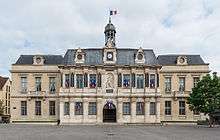
The great fire of 1524 destroyed much of the medieval city, although the city had numerous canals separating sections.
Main sights
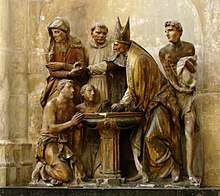
- Many half-timbered houses (mainly of the 16th century) survive in the old town
- Hôtels Particuliers (palaces) of the old town
- The Hôtel de Ville, Place Alexandre Israël, is an urbane example of the style Louis XIII. On the central corps de logis, which contains the main reception rooms, its cornice is rhythmically broken forward over paired Corinthian columns; these are supported below by strong clustered pilasters. Above the entrance door the statue of Louis XIV was pulled out of its niche and smashed in 1793, during the Reign of Terror at the height of the French Revolution; it was replaced in the nineteenth century with the present Helmeted Minerva and the device in its original form. It is now rare to see "Liberté, Egalité, Fraternité, ou la Mort". In the Salle du Conseil (Council Chamber) a marble medallion of Louis XIV (1690) by François Girardon, born at Troyes, survived the destruction unscathed.
Museums
- Museum of Modern Art (Musée d'Art Moderne)
- Maison de l'outil et de la pensée ouvrière
- Vauluisant Museum :
- Historical museum of Troyes and Champagne-Ardenne
- Museum of hosiery
- Hôtel-Dieu-Lecomte apothecary
- Saint-Loup Museum (museum of fine arts)
- Di Marco Museum (Open from 1 April to 1 October, each year)
Churches
Not having suffered from the last wars, Troyes has a high density of old religious buildings grouped close to the city centre. They include:
- Saint-Pierre-et-Saint-Paul Cathedral
- Saint-Nizier Church, in Gothic and Renaissance style, with remarkable sculptures. Classified as a Monument Historique (French equivalence) in 1840.
- The Gothic Saint-Urbain Basilica (thirteenth century), with a roofing covered by polished tiles. It was built by Jacques Pantaléon, who was elected pope in 1261, under the name of Urbain IV, on grounds where his father had a workshop. Classified Monument Historique in 1840. It was proclaimed a basilica in 1964.
- Sainte-Madeleine Church. Very early Gothic, with east end rebuilt around 1500. Remarkably elaborate stone rood screen of 1508-17 in Flamboyant Gothic style, sculpted by Jean Gailde, with a statue of Saint Martha. Fine Renaissance stained glass. Saint Jean district. Classified Monument historique in 1840.
- Saint-Jean Church, with a Renaissance chancel, tabernacle of the high altar by Giraudon. On the portal, coat of arms of Charles IX. Classified Monument Historique in 1840.
- Gothic Saint-Nicolas Church, dating to the beginning of the sixteenth century, with a calvary chapel -shaped rostrum reached by a monumental staircase. On the south portal, two sculptures by François Gentil of David and Isaiah.
- Saint-Pantaléon Church, with extensive statuary from the sixteenth century.
- Saint Remy Church, with a 14th-century spire rising to a height of 60 m (196.85 ft). A 17th-century sundial on its south side bears the Latin inscription sicut umbra dies nostri super terram ("our days on earth pass like a shadow").
- Church of Saint-Martin-ès-Vignes. It has stained glass windows of the seventeenth century by the local master verrier Linard Gonthier.
Several Troyes churches have sculpture by The Maitre de Chaource.
Climate
| Climate data for Troyes (1981–2010 averages) | |||||||||||||
|---|---|---|---|---|---|---|---|---|---|---|---|---|---|
| Month | Jan | Feb | Mar | Apr | May | Jun | Jul | Aug | Sep | Oct | Nov | Dec | Year |
| Record high °C (°F) | 16.2 (61.2) |
20.4 (68.7) |
23.7 (74.7) |
27.8 (82.0) |
31.0 (87.8) |
37.9 (100.2) |
38.6 (101.5) |
40.6 (105.1) |
33.7 (92.7) |
30.3 (86.5) |
22.8 (73.0) |
19.0 (66.2) |
40.6 (105.1) |
| Average high °C (°F) | 6.2 (43.2) |
7.7 (45.9) |
11.9 (53.4) |
15.2 (59.4) |
19.5 (67.1) |
22.7 (72.9) |
25.7 (78.3) |
25.4 (77.7) |
21.2 (70.2) |
16.3 (61.3) |
10.1 (50.2) |
6.7 (44.1) |
15.8 (60.4) |
| Average low °C (°F) | −0.1 (31.8) |
−0.3 (31.5) |
2.0 (35.6) |
3.7 (38.7) |
7.8 (46.0) |
10.7 (51.3) |
12.8 (55.0) |
12.6 (54.7) |
9.6 (49.3) |
9.8 (49.6) |
3.0 (37.4) |
0.8 (33.4) |
5.8 (42.4) |
| Record low °C (°F) | −23.0 (−9.4) |
−17.6 (0.3) |
−15.4 (4.3) |
−6.2 (20.8) |
−2.0 (28.4) |
0.4 (32.7) |
3.1 (37.6) |
3.0 (37.4) |
−0.4 (31.3) |
−7.0 (19.4) |
−11.1 (12.0) |
−18.0 (−0.4) |
−23.0 (−9.4) |
| Average precipitation mm (inches) | 50.5 (1.99) |
42.1 (1.66) |
47.7 (1.88) |
50.9 (2.00) |
61.7 (2.43) |
56.6 (2.23) |
54.4 (2.14) |
52.2 (2.06) |
53.3 (2.10) |
63.6 (2.50) |
51.2 (2.02) |
60.6 (2.39) |
644.8 (25.39) |
| Average precipitation days | 10.6 | 9.2 | 10.5 | 9.5 | 10.5 | 9.3 | 7.6 | 7.7 | 8.2 | 9.7 | 10.3 | 11.3 | 114.5 |
| Mean monthly sunshine hours | 68.6 | 88.3 | 143.8 | 184.8 | 215.0 | 229.4 | 235.5 | 228.2 | 179.2 | 123.6 | 66.6 | 53.6 | 1,816.4 |
| Source: Météo France[8][9] | |||||||||||||
Population
| Year | Pop. | ±% |
|---|---|---|
| 2006 | 61,344 | — |
| 2007 | 61,823 | +0.8% |
| 2008 | 61,544 | −0.5% |
| 2009 | 61,188 | −0.6% |
| 2010 | 60,280 | −1.5% |
| 2011 | 60,013 | −0.4% |
| 2012 | 60,009 | −0.0% |
| 2013 | 59,671 | −0.6% |
| 2014 | 60,750 | +1.8% |
| 2015 | 60,928 | +0.3% |
| 2016 | 60,640 | −0.5% |
The inhabitants of the commune are called Troyens.
Economy
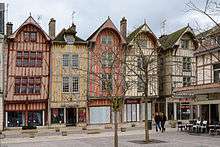
Troyes is home to the production headquarters of Lacoste company, a popular clothing brand. It is also home of prize-winning chocolatier Pascal Caffet.[10]
Transport
The train station Gare de Troyes offers connections to Paris, Dijon, Mulhouse and several regional destinations. Troyes is at the junction of motorways A5 (Paris – Troyes – Langres) and A26 (Calais – Reims – Troyes). Troyes – Barberey Airport is a small regional airport.
Sport
Troyes is the home of association football club Troyes AC, or ESTAC. ESTAC now plays in Domino's Ligue 2.
In popular culture
- Troyes (2010) is a board game named after the city, published by Pearl Games, UPlay.it edizioni, and Z-Man Games.[11][12]
- Chapter 28 of James Rollins' sixth Sigma Force novel, The Doomsday Key (2009), is named "Troyes, France," as the city plays an important role in the plot.
Notable people
- Jean-Marie Bigard, French stand-up comedian, writer, and director
- Saint Marguerite Bourgeoys, (1620–1700), a founder of Congregation of Notre Dame of Montreal and the city of Montreal
- Gilles Buck (1935–2010), French sailor who competed in the 1968 Summer Olympics.
- Émile Coué (1857–1926), pharmacist, hypnotist, and creator of La méthode Coué ("Every day, in every way, I'm getting better and better")
- Hughes de Payens (1070–1136), Knight of the First Crusade and founder of the Knights Templar
- Chrétien de Troyes, 12th-century trouvère
- François Girardon (1628–1715), sculptor
- Linard Gonthier (1565 – after 1642), stained-glass artisan (verrier)
- François-Pierre Goy (born 1960), musicologist
- Édouard Herriot (1872–1957), Radical politician of the Third Republic, three-time Prime Minister of France
- André Lefèvre (1717–1768), contributor to the Encyclopédie
- Maurice Marinot (1882–1960), glass artist, painter
- Pierre Mignard (1610–1695), painter
- Jacques Pantaléon, (c. 1195–1264), Pope Urban IV
- Patroclus of Troyes (3rd century), martyr
- Pierre Pithou (1539–1596), Calvinist jurisconsult and scholar, co-editor of the Satire Ménippée
- Rashi (1040–1105), biblical and Talmudic commentator
- Rabbeinu Tam (1100–1171), rabbi and Rashi's grandson
- Maxime Rouyer, CFL linebacker for the Edmonton Eskimos.
- Béatrice Saubin (1959–2007), first foreign national to be sentenced to death in Malaysia for drug smuggling
- Djibril Sidibé, footballer
- Nicolas Siret (1663–1754), composer
- Abdou Sissoko footballer
- Gaëtane Thiney (1985), footballer and team captain of Paris FC (women), current member of France women's national football team, Cyprus Cup winner: 2012, 2014, 2017 SheBelieves Cup champion, UEFA Women's Under-19 Championship: 2003, an all-star team member of the UEFA Women's Championship All-Star Team: 2013, two-time winner player of the year
- Jean Tirole, Nobel Award in Economics
- Aldebrandin of Siena, physician
Twin towns
Troyes is twinned with:[13]


.svg.png)



See also
References
- "Populations légales 2017". INSEE. Retrieved 6 January 2020.
- "L'énigme de la Tombe Celte" (arte, French): 1 h 13 min 02 sec and following. https://www.youtube.com/watch?v=E2a0w6dQAn0
- Traces of the Roman paving lie 3 m (9.84 ft). below the rue de la Ciré.("Balades dans l'histoire du vieux Troyes")
- Princeton Encyclopedia of Classical Sites
- Ptolemy, Geography 8.13, mentions the Tricasses and their city Augustobona.
- Attwater, Donald. The Penguin Dictionary of Saints, (1945) Reprint: 1981, p. 223.
- Lloyd, John; Mitchison, John (2010). The Second Book of General Ignorance (First ed.). London: Faber and Faber Ltd. p. 71. ISBN 978-0-571-26965-5.
- "Données climatiques de la station de Troyes" (in French). Meteo France. Retrieved 4 January 2016.
- "Climat Champagne-Ardenne" (in French). Meteo France. Retrieved 4 January 2016.
- chocolatier. "Pascal Caffet, Meilleur Ouvrier de France pâtissier, Champion du monde des métiers du dessert". Pascal-caffet.com. Retrieved 16 September 2011.
- "Troyes (2010)". Board Game Geek.
- "Troyes (2010)". Z-Man Games. Archived from the original on 9 July 2014. Retrieved 23 September 2014.
- "Nos villes jumelles". ville-troyes.fr (in French). Troyes. Retrieved 16 November 2019.
Bibliography
External links
| Wikimedia Commons has media related to Troyes. |

- (in French)Troyes city council website